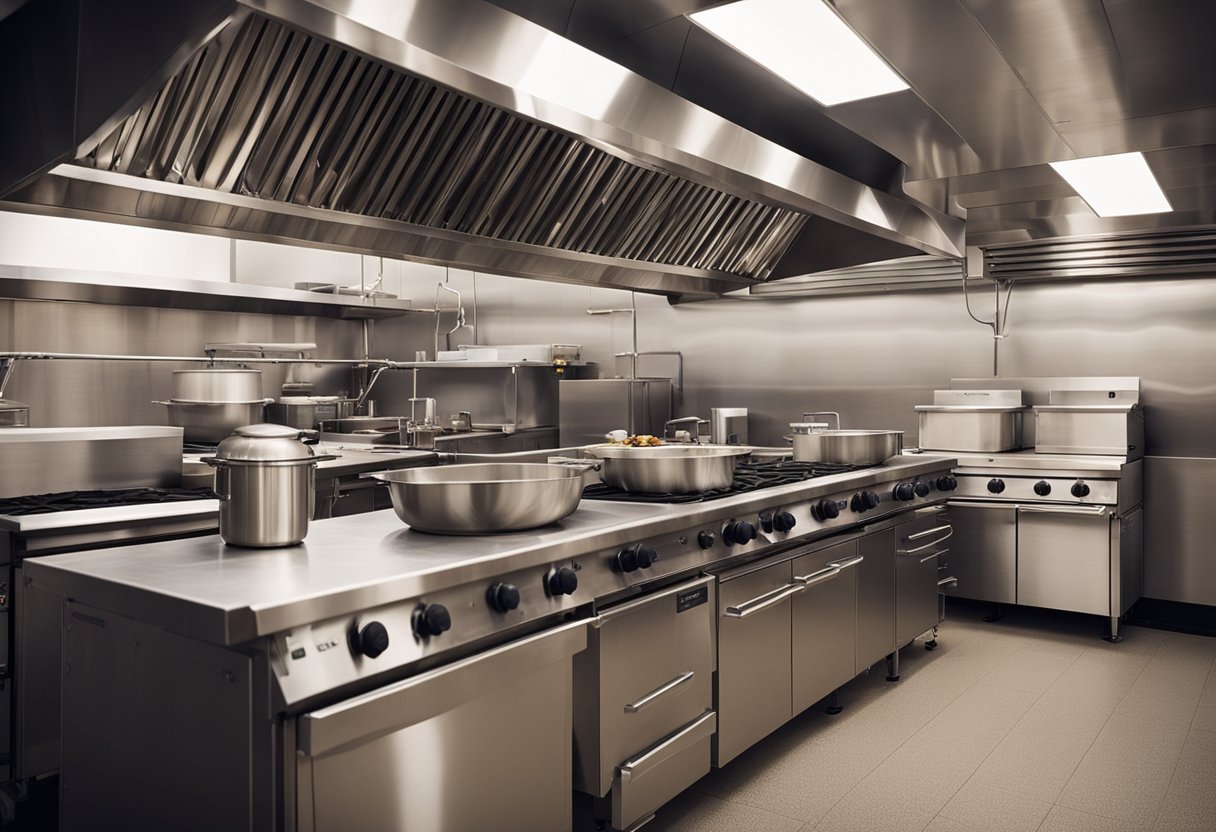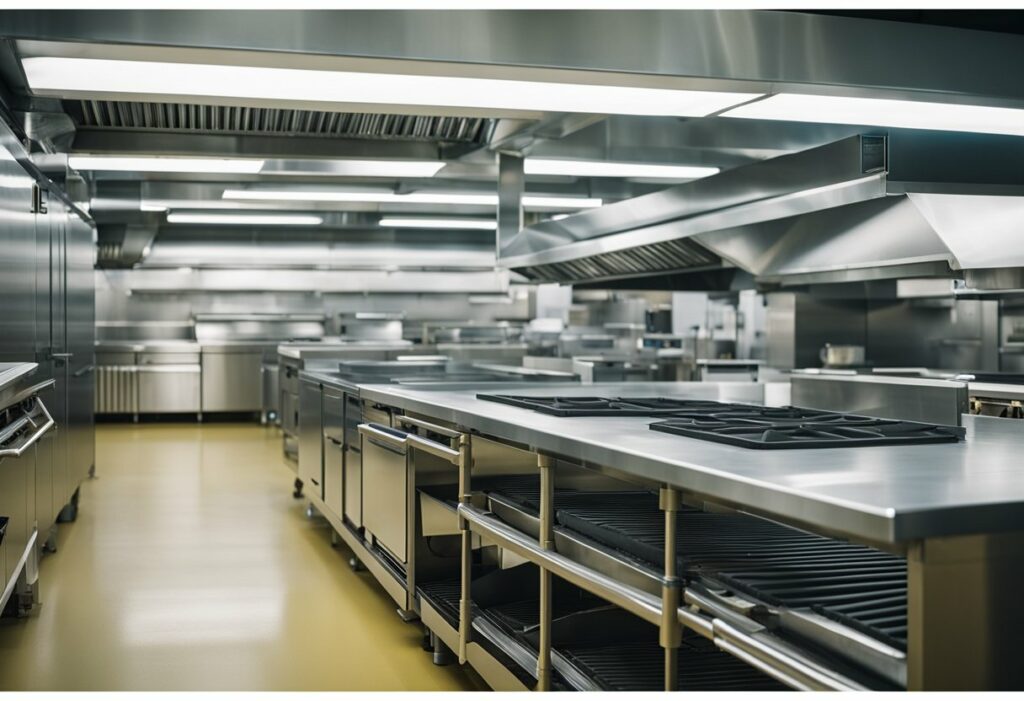Commercial Kitchen HVAC Design: Maximising Efficiency and Comfort
Are you planning to open a new restaurant or renovate an existing one? If so, you need to pay attention to the design of your commercial kitchen HVAC system. A properly designed HVAC system is essential for ensuring that your kitchen is safe, comfortable, and energy-efficient.

Commercial kitchen HVAC design is a complex process that involves several factors, such as ventilation, air conditioning, heating, and air quality. The design should take into account the size and layout of your kitchen, the type of equipment you use, and the volume of food you produce. A well-designed HVAC system will not only improve the working conditions for your staff but also help you save on energy costs in the long run.
Fundamentals of Commercial Kitchen HVAC Design

If you are planning to set up a commercial kitchen, then you must have a proper HVAC system in place. A well-designed HVAC system will ensure that your kitchen is comfortable, safe, and energy-efficient. Here are some fundamentals of commercial kitchen HVAC design that you should keep in mind.
Understanding Ventilation and Airflow
Ventilation and airflow are critical components of a commercial kitchen HVAC system. Proper ventilation ensures that the air inside the kitchen is free of smoke, heat, and humidity. It also helps to maintain a comfortable temperature inside the kitchen. Airflow requirements vary depending on the size and layout of the kitchen, the type of cooking equipment used, and the number of people working in the kitchen.
Key Components of HVAC Systems
An HVAC system for a commercial kitchen typically comprises three key components: air conditioning, ventilation, and ductwork. Air conditioning helps to maintain a comfortable temperature inside the kitchen, while ventilation ensures that the air inside the kitchen is free of smoke, heat, and humidity. Ductwork is used to transport air from the kitchen to the outside environment.
Importance of Exhaust Hoods and Ductwork
Exhaust hoods and ductwork are critical components of a commercial kitchen HVAC system. Exhaust hoods help to remove smoke, heat, and humidity from the kitchen, while ductwork is used to transport the air outside. The size and type of exhaust hood needed will depend on the size and layout of the kitchen, the type of cooking equipment used, and the number of people working in the kitchen. Properly designed and installed ductwork is essential to ensure that the air is transported efficiently and safely outside the building.
In summary, a well-designed HVAC system is critical for any commercial kitchen. Understanding ventilation and airflow, key components of HVAC systems, and the importance of exhaust hoods and ductwork are essential components of commercial kitchen HVAC design.
Optimising Performance and Safety

Designing a commercial kitchen ventilation system that meets your specific needs is a crucial step in optimising both safety and efficiency. Here are some key considerations to keep in mind when designing and operating your system.
Ensuring Efficient Energy Consumption
A well-designed commercial kitchen ventilation system can help you save energy and reduce costs. You can achieve this by selecting the right equipment, such as hoods and fans, that are sized appropriately for your kitchen and cooking equipment. It is also important to consider the layout of your kitchen, as this can affect the efficiency of your ventilation system. For example, placing cooking equipment in a way that minimizes the distance between the equipment and the hood can help reduce the amount of air that needs to be exhausted.
Compliance with Codes and Standards
Compliance with codes and standards is essential for ensuring the safety of your commercial kitchen ventilation system. The International Mechanical Code (IMC) and ASHRAE Standard 154 provide guidelines for the design, installation, testing, balancing, and commissioning of commercial kitchen ventilation systems. It is important to work with a qualified HVAC engineer who is familiar with these codes and standards to ensure that your system meets all requirements.
Maintenance and Operational Best Practices
Regular maintenance and operational best practices are critical to ensuring the safety and efficiency of your commercial kitchen ventilation system. A well-designed maintenance schedule can help prevent breakdowns and ensure that your system is operating at peak efficiency. It is also important to perform regular inspections and testing to identify any potential issues before they become major problems.
Fire safety is also a key consideration when it comes to commercial kitchen ventilation systems. It is important to ensure that your system is equipped with fire suppression equipment, such as automatic fire extinguishers, and that all equipment is properly maintained and tested. Working with an HVAC professional who is familiar with fire safety codes and regulations can help ensure that your system is in compliance.
The ASHRAE Technical Committee on Commercial Kitchen Ventilation Systems provides guidance and information on best practices for designing and operating commercial kitchen ventilation systems. By following these guidelines and working with a qualified HVAC engineer, you can ensure that your system is operating safely and efficiently, while also reducing costs and improving overall performance.
Frequently Asked Questions

What are the latest guidelines for efficient ventilation in commercial kitchens?
The latest guidelines for efficient ventilation in commercial kitchens are set by the Chartered Institution of Building Services Engineers (CIBSE) and the Heating and Ventilation Contractors’ Association (HVCA). These guidelines recommend that the ventilation system should be designed to remove all the heat, moisture, and cooking odours from the kitchen. It should also be designed to replace the air in the kitchen at least ten times per hour. This ensures that the air quality in the kitchen is good, and the risk of fire is reduced.
How can I calculate the correct CFM for my commercial kitchen to ensure proper ventilation?
To calculate the correct CFM for your commercial kitchen, you will need to consider the size of your kitchen, the type of cooking equipment you use, and the number of people who work in the kitchen. You can use the CIBSE and HVCA guidelines to determine the CFM required for your kitchen. You can also consult with a professional HVAC contractor who can help you determine the correct CFM for your kitchen.
What are the cost-effective solutions for installing HVAC in a restaurant setting?
The cost-effective solutions for installing HVAC in a restaurant setting include using energy-efficient HVAC systems, installing programmable thermostats, and using natural ventilation whenever possible. Energy-efficient HVAC systems can help reduce your energy bills and improve the air quality in your restaurant. Programmable thermostats can help you control the temperature in your restaurant, which can help you save money on your energy bills. Natural ventilation can help improve the air quality in your restaurant and reduce your energy bills.
Can air conditioning systems be integrated within commercial kitchens, and how?
Yes, air conditioning systems can be integrated within commercial kitchens. However, they need to be designed and installed properly to ensure that they do not interfere with the ventilation system. Air conditioning systems can help maintain a comfortable temperature in the kitchen, which can improve the working conditions for the staff. They can also help reduce the humidity levels in the kitchen, which can help prevent the growth of mould and bacteria.
What are the best practices for maintaining air quality in a commercial kitchen environment?
The best practices for maintaining air quality in a commercial kitchen environment include cleaning the kitchen regularly, maintaining the ventilation system, using proper cooking techniques, and using high-quality air filters. Cleaning the kitchen regularly can help reduce the amount of grease and dirt in the air, which can improve the air quality. Maintaining the ventilation system can help ensure that the air in the kitchen is replaced regularly. Using proper cooking techniques can help reduce the amount of smoke and cooking odours in the air. Using high-quality air filters can help remove contaminants from the air, which can improve the air quality.
How does the ASHRAE design guide influence the ventilation setup in modern commercial kitchens?
The ASHRAE design guide is a comprehensive guide that provides information on the best practices for designing and installing HVAC systems in commercial kitchens. It provides guidelines for the proper ventilation of the kitchen, the selection of equipment, and the control of the indoor environment. The ASHRAE design guide has influenced the ventilation setup in modern commercial kitchens by providing a framework for the design and installation of HVAC systems. It has also helped to improve the energy efficiency of HVAC systems in commercial kitchens.



